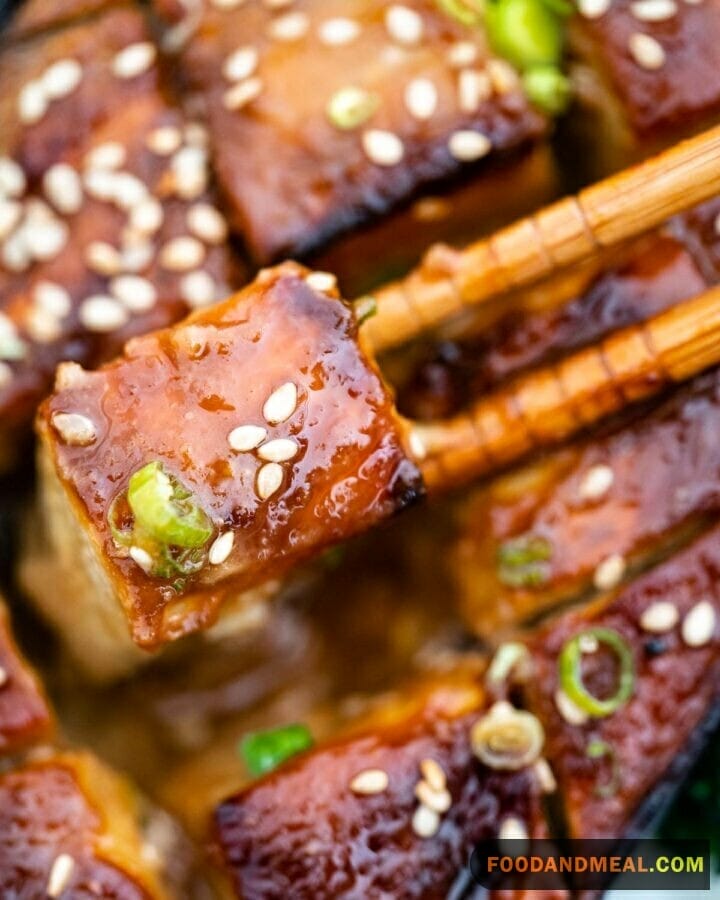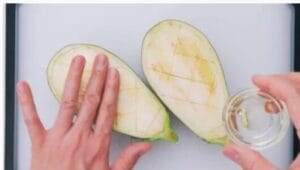I’m so excited to share my latest culinary discovery – Nasu Dengaku! This sweet and savory Japanese eggplant dish has completely won me over. As someone who has struggled with cooking eggplant in the past, finding this recipe felt like striking gold. The miso glazed eggplant slices are utter perfection – tender, beautifully caramelized, and packed with complex flavors.
What drew me to Nasu Dengaku was my recent journey into Japanese cuisine. I’ve fallen head over heels for the balanced flavors, artful presentations, and focus on quality ingredients. At the same time, I know eggplant is so nutritious and wanted to find more ways to enjoy it. This dish brings together the best of both worlds.
The first time I took a bite, I was stunned by the sweet and nutty miso glaze enveloping the creamy eggplant. It made me realize eggplant can be so much more than just a sponge for oil! Now I can’t get enough of this combination. The sake, mirin, and touch of sugar in the sauce add lovely depth without overpowering the eggplant’s natural flavor.
I love sharing this recipe because it’s surprisingly easy to make at home yet tastes gourmet. The eggplant cooks up perfectly tender without any oiliness or mushiness. Trust me, this will convert anyone who claims not to like eggplant! I hope you’ll give miso glazed eggplant a try and let the sweet, savory goodness win you over too. Just thinking about it makes my mouth water. Please enjoy!
Nasu Dengaku Recipes


Japanese Sweet Miso Baked Eggplant ( Nasu Dengaku )
Equipment
Ingredients
- 2 small eggplants
- 2 tbsp canola oil
- Cup miso paste
- 2 tbsp mirin
- 1 tbsp sugar granulated
- 1 tbsp sake Sesame seeds
Instructions
- Slice eggplant into half then score its inside into squares.

- Pour oil on a pan (Drizzle most of the oil on the cut sides of the eggplant, rubbing it in with your fingers. Then, apply any remaining oil to the skin side, rubbing it in as well ). Then cook the eggplant with the skin facing down. Cook until the skin is browned.

- Turn the eggplant, lid the pan, and cook for four Minutes.

- Meanwhile, mix the miso paste, mirin, granulated sugar, and sake in a small mixing bowl.

- Line a cook tray with foil then place the cooked eggplant on it. Coat the eggplant with miso mixture then broil in an oven for four Minutes.

- Sprinkle sesame seeds and serve. Enjoy when hot.

Video
Notes
Nutrition
© Food And Meal
This website provides approximate nutrition information for convenience and as a courtesy only. Nutrition data is gathered primarily from the Spoonacular Database, whenever available, or otherwise other online calculators.
Nasu Dengaku Air Fryer recipe

To make this dish, start by selecting fresh, firm eggplants. Cut them into halves, score the flesh in a crisscross pattern to allow deeper penetration of flavors. Brushing the eggplants with oil, air fry at 360°F (182°C) for about 10 minutes, until they’re tender.
The charm of this dish lies in the sweet and savory glaze. Combine white miso paste, mirin, sugar, and a dash of soy sauce, adjusting to taste for that perfect balance. Once the eggplants are tender, spread the miso mixture over the cut side and air fry for an additional 2-3 minutes until caramelized. The result is a heartwarming blend of textures and tastes – the outside is slightly crisp, while the inside remains succulent and comforting.
Expert tips

Cooking notes
First, select eggplants that are firm and glossy for freshness. When slicing them, cut deep enough to allow the miso to permeate, but be careful not to pierce the skin completely.
The emotional aspect of cooking comes into play with the miso glaze—a harmonious blend of sweet and savory. One should feel joy in whisking together the miso paste, mirin, and sugar, creating a mixture that will caramelize beautifully under the broiler.
Before applying the glaze, it’s essential to score the flesh in a crosshatch pattern, enhancing the textural experience and allowing flavors to infuse deeply. Pre-cooking the eggplant until it’s tender ensures it won’t become overly dry once glazed.
Broiling requires attentiveness—watching as the glaze bubbles and turns a rich, golden brown, which gives an immense sense of anticipation for the first bite. The result should be a delightful contrast between the creamy eggplant and the umami-rich crust.
How to Serving

Nasu Dengaku pairs wonderfully with some classic Japanese sides like steamed rice cooked by Rice Cooker From Japan, miso soup, and lightly dressed salads. For a more substantial meal, consider serving it alongside sautéed gyoza dumplings, karaage fried chicken, or yakisoba noodles. The sweet and savory glazed eggplant also makes a lovely small plate for grazing, served with an assortment of pickles, edamame, and wasabi.
I like to keep the sides simple to let the star of the show – the Nasu Dengaku – shine. A few easy suggestions:
- Steamed jasmine or sushi rice
- Miso soup with tofu, wakame seaweed, and scallions
- Mixed greens dressed with rice vinegar and sesame oil
- Quick-pickled cucumbers, carrots, or radishes
- Sautéed spinach or bok choy
- Pan-fried gyoza potstickers
The umami-packed miso glazed eggplantu also pairs well with sake, Japanese beer, green tea, or even a crisp white wine. I hope you’ll give this recipe a try soon – the eggplant comes out sweet, savory, and utterly addictive!
Top 8 FAQs about Nasu Dengaku

- What is Nasu Dengaku?
- It is a Japanese dish made by grilling or broiling eggplants and coating them with a sweet miso glaze known as dengaku.
- What does “Kamo Nasu no Dengaku” mean?
- “Kamo Nasu no Dengaku” refers to Nasu Dengaku made specifically with Kamo eggplant, a type of Japanese eggplant.
- Can I eat the skin of Nasu Dengaku?
- Yes, the skin of it is generally edible, especially when the eggplants are cooked until soft. However, personal preferences may vary.
- Are Chinese and Japanese eggplant the same?
- No, Chinese and Japanese eggplants are similar but not exactly the same. Japanese eggplants are typically longer and slender, while Chinese eggplants are longer and often have a lighter color.
- Can I use regular eggplants instead of Japanese eggplants for Nasu Dengaku?
- While Japanese eggplants are ideal, you can use regular eggplants if necessary. Just be aware that their texture and flavor may differ slightly.
- What’s the difference between red and white miso for the Dengaku sauce?
- Red miso offers a stronger, richer flavor, while white miso is milder. You can choose based on your taste preference.
- How long can I store leftover Nasu Dengaku?
- Leftover this grilled eggplants can be refrigerated for up to two days. Reheat it in the oven or microwave before serving.
- Can I make Nasu Dengaku ahead of time for a party?
- Yes, you can. Prepare the eggplants and Dengaku sauce in advance, then assemble and broil them just before serving for the best flavor.
Conclution
I hope this recipe for Nasu Dengaku has inspired you to give Japanese eggplant a try if you haven’t before. The miso glazed eggplant is so delicious, I think it will turn even eggplant skeptics into fans!
Let me know if you make this dish at home. I’d love to see your beautiful creations and hear how the Nasu Dengaku turns out. Feel free to share pictures on Food And Meal’s Facebook page or tag @foodandmeal on Instagram so others can discover this tasty recipe too.
Thanks for reading this recipe post on Food And Meal! Be sure to come back next week when I’ll be sharing another awesome Japanese comfort food recipe. I can’t wait for you all to try it. Until then, happy cooking!
I'm James F Anderson, a noted sous chef from London and a Le Cordon Bleu alumnus. My career began in a Michelin-starred Parisian eatery, where my blend of classic and contemporary cooking, using seasonal ingredients, earned accolades. Recognized in culinary publications and on cooking shows, I’m committed to mentoring aspiring chefs and delivering memorable dining experiences, marking me as a standout talent in the culinary world.








